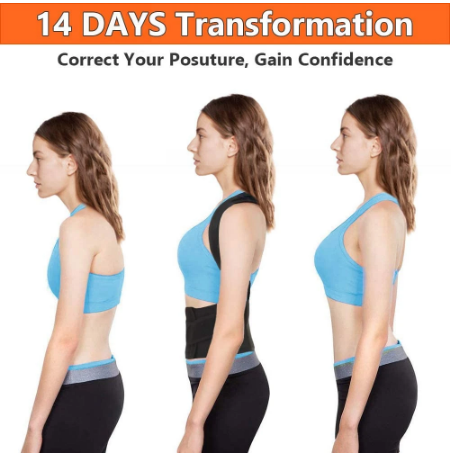
Posture Correction 101: Understanding the importance of good posture
Table of Contents
Posture correction refers to the alignment of your body when sitting, standing, or lying down. It is the position in which your body is held, and it plays an important role in maintaining overall health and well-being.
Good posture can help to reduce stress on your muscles, bones, and joints, and it can also help to improve your overall appearance.
Importance of good posture

Good posture is essential for maintaining a healthy and pain-free body. It helps to keep your spine in its natural alignment, which can reduce the risk of back pain and other musculoskeletal problems.
Also read: Yoga For Beginners: A guide to getting started
Additionally, good posture can help to improve your breathing and circulation, which can lead to better overall health. Good posture also helps to project confidence and can make a person look taller and slimmer.
Having a good posture not only improves your physical health but also has psychological benefits, it can boost your self-esteem, reduce stress and depression, and can help you to feel more energized and alert.
When you stand tall, you are more likely to feel confident and to be perceived as confident by others. This can be especially beneficial in social and professional situations.
The effects of poor posture
Physical effects
- Back pain: Poor posture can put unnecessary strain on the muscles and ligaments in the back, which can lead to chronic back pain. Slouching or hunching over can cause the spine to curve unnaturally, which can lead to muscle imbalances and pain.
- Neck pain: Poor posture can also lead to neck pain. When the head is held forward or tilted to one side, it can cause strain on the neck muscles, which can lead to pain and stiffness.
- Headaches: Poor posture can also lead to headaches, particularly tension headaches. This can be caused by the tension in the muscles of the neck and shoulders, which can lead to headaches.
- Poor circulation: Poor posture can also affect circulation. When sitting or standing for long periods with poor posture, the muscles in the legs and feet can become compressed, which can restrict blood flow and lead to poor circulation.
Psychological effects
- Low self-esteem: Poor posture can also affect a person’s self-esteem. When a person slouches or slumps, it can give the impression of a lack of confidence and can make a person feel self-conscious.
- Depression: Poor posture can also contribute to feelings of depression. When a person is in a slumped position, it can give the impression of feeling defeated or helpless, which can lead to feelings of depression.
- Fatigue: Poor posture can also lead to fatigue. When the muscles are held in a strained position for extended periods, it can lead to fatigue, making it harder to maintain good posture and energy throughout the day.
Also read: Stress-Relief 101: Understanding the causes and effects of stress
Thus, poor posture can lead to a host of physical and psychological effects, including back pain, neck pain, headaches, poor circulation, low self-esteem, depression, and fatigue.
It’s important to be aware of your posture and to make an effort to maintain good posture throughout the day to avoid these negative effects.
Tips for posture correction
Strengthening exercises

- Core exercises: When you strengthen the core muscles your posture also improves. Core exercises such as planks, bridges, and bird dogs can help to strengthen the muscles that support the spine, which can help to improve posture.
- Upper back exercises: Strengthening the upper back muscles can also help to improve posture. Exercises such as rows, pull-ups, and chin-ups can help to strengthen the muscles that support the upper back, which can help to improve posture.
- Lower back exercises: Strengthening the lower back muscles can also help to improve posture. Exercises such as deadlifts, good mornings, and back extensions can help to strengthen the muscles that support the lower back, which can help to improve posture.
Stretches
- Shoulder stretches: Stretching the shoulders can help to improve posture. Shoulder stretches such as arm crosses, shoulder rolls, and shoulder blade squeezes can help to loosen tight muscles and improve posture.
- Chest stretches: Stretching the chest muscles can also help to improve posture. Chest stretches such as doorway chest stretch, wall angles, and chest opener can help to open up the chest and improve posture.
- Lower back stretches: Stretching the lower back muscles can also help to improve posture. Lower back stretches such as the child’s pose, spinal twist, and the cat-cow stretch can help to loosen tight muscles and improve posture.
Also read: Back Pain Relief: Understanding the causes and effective treatments
Mindfulness
- Awareness of posture: Being aware of your posture can help you to make corrections when needed. Try to check your posture throughout the day and make adjustments as necessary.
- Setting reminders: Setting reminders to check your posture can help to make it a habit. You can set reminders on your phone or computer, or you can use a posture tracker.
- Incorporating posture into a daily routine: Incorporating good posture into your daily routine can help to make it a habit. Try to maintain good posture when sitting, standing, and walking.
Thus, correcting posture requires a combination of exercises, stretches, and mindfulness.
Also read: Meditation For Beginners: A guide to getting started
By strengthening the core, upper back, and lower back muscles, stretching the shoulders, chest, and lower back muscles, and incorporating good posture into our daily routine we can make posture correction a habit and avoid the negative effects of poor posture.
It is important to remember that if you are experiencing chronic pain, it is always best to consult a healthcare professional.
They can help to diagnose the cause of the pain and provide guidance on how to manage it. They may recommend specific exercises, stretches, or other treatments to help alleviate the pain and improve posture.
In conclusion, good posture is essential for maintaining a healthy and pain-free body, it also has many psychological benefits like boosting self-esteem, and reducing stress and depression.
Incorporating exercises stretches, and mindfulness into our daily routine can make posture correction a habit and avoid the negative effects of poor posture. But if you are experiencing chronic pain it’s important to consult a healthcare professional for guidance.
Continue reading: Weight Loss Tips: The ultimate guide to successful weight loss



